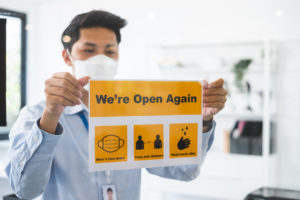COVID-19: What comes next?

COVID-19: What comes next?
It the hot topic of the day – what comes after COVID? Progress has been made on COVID, and yet…so much is still to come.
A lot of you have been asking for predictions on what comes next after COVID. Similarly, we’ve been getting a ton of data from various firms looking to predict the changes that will come to society and the marketplace post-Covid.
(Shh) No one knows. That is the truth. Anyone who tells you they know the future post-Covid is basing that on what we can measure right now, but we’re all still in the middle of it.
Yes, we can see trends and indicators today. Yes, we can start to anticipate changes. But the final answer of how things will change over time is yet to be uncovered.

The questions I have for you are:
- How are you tracking changes in your people, customers, the market?
- How will you navigate those changes and stay on top of evolving needs, wants and core emotional motivation?
- How will you take care of yourself during all this? (Remember, you are a person in the middle of all of this too!)
For this issue of the newsletter, I’d like to give you some guideposts as we move forward.
- Examples of major shifts from the past. Looking back over the last several decades, what can we learn about major shifts?
- Key questions to ask your employees, customers, and partners.
- Signposts to look for. Covid has changed us all. The question is what will that change be and how lasting will those changes be? I’ll give you some things to look out for.
- Trends and studies for further reading. What we’re hearing and seeing in the marketplace now.
When you know what to look for, you’re more likely to see what is coming.
I hope you enjoy this exploration of what we know, what we don’t know and how to keep your eyes open to what lies ahead.
Examples of major shifts from the past:
When humans endure a major crisis, it alters our way of living and forever changes our needs. When the (this) new world begins to crystalize, market leaders change, the deck gets reshuffled, and we get to experience how chaos creates both risk AND opportunity.
The Renaissance Period emerged from the Bubonic Plague. The Roaring 20s emerged from the Spanish Flu. Here is an illustration of a foundational shift on what success looks like from just the past few decades.
Changing views of success:
- In the 1980’s Yankelovich created a comprehensive study on how people define success. The answer in the 1980’s was “having a lot of money.”
- In the 1990’s the company repeated the study, and the answer was “flexibility of time.” In short, people who were considered successful were seen as being able to work when they wanted to, go out to a longer lunch, come in late, and work odd hours.
- In the 2000’s the answer was “flexibility of place.”. A successful person had access to technology that allowed him or her to work wherever they liked.
- After the 2008/2009 Recession, the answer changed to “working with purpose.” Young Millennials were slammed up against the cold truth that working hard today didn’t guarantee success tomorrow. Many of them became Depression Era super savers, some thought “what’s the point?” Almost all agreed that success needed to be redefined. As a society, we decided that people who are successful are doing work that matters to them, not waiting for retirement to start to give themselves permission to do what they love.

Who would have guessed that an economic downturn would lead a dramatic shift in how we define success?
What do you think the next major shift will be?
How will you ride the wave of change?
Key questions to ask your employees, customers and partners:
When Covid first hit, I was surprised to see the impact on my amazing and strong team. Everyone was in it to win it, but we were all feeling the pressure. I realized that it was up to me as a leader to check in with people and give them space to be vulnerable, to admit that they needed something different or couldn’t live up to the reputations they had built for themselves. Here are some questions to consider:
- How are you doing (really)? How is your family or loved ones?
- What can I do to best support you?
- Are you interested in doing more, less work? Doing work in a different way? How can I facilitate this?
- If your team is coming back into the office, don’t assume how people may be reacting. Ask! How are you feeling about coming back? What would you like to see happen? You may or may not be able to accommodate their wishes, but it’s very important to know what people need and how they are feeling.
- If you work with a small business owner or contractor, check in on your payment terms. Many larger firms have a 90 to 120 pay cycle, which can be very tough. We have a couple of clients where we offer a 2% discount for 100% payment net 10 days, and it really makes a difference! Are you able to work with procurement or your accounting department to help make life easier for your vendor partners in terms of cash flow?
Signposts to look for:
We know COVID has had a major impact in the following ways. Be on the lookout for how these trends will influence the future. Right now, we know some of the impacts from COVID, but the final word is still out on what the long-term implications will be.
- Women, people of color and low-wage workers have been the most impacted economically by COVID.
- Covid has driven women from the workforce, which not only impacts their income but also their ongoing wealth as they lose out on retirement benefits and have lower savings rates
- People of color have experienced a disproportionate impact from COVID, further expanding the wealth and health gaps
- Low-wage, low-hour workers were hardest hit economically. People who were on the edge of disaster have hit that disaster or are about to
- Children have lost a ton of social contact because of COVID. Some thrived – some special needs kids got more attention, some kids who were being bullied could concentrate. But many were negatively impacted, particularly those in rural and low-income areas with a lack of Broadband, who couldn’t even have contact with teachers on Zoom. In some families, older children were left to take care of younger children in the family, which further reduced social contact with their peers and diminished the educational opportunities for everyone.
- Our idea of the employee/employer relationship is changing. Workers are leaving jobs that have low pay or a negative work environment. Still, others are living on less money, finding ways to work remotely or re-thinking their careers. How will these changes redefine the relationship between employers and employees? How will HR respond to the tension between companies wanting workers to go back to the old ways and workers wanting a new future?
- We found out we could live differently. Will we keep some of that? From flexible hours and remote working to spending more time with our families, we have all come to accept and even find ways to thrive in the new normal. Now that we know what our choices really are, what will we want or accept going forward?
Resources
Trends and studies for future reading:
CNBC 7/17/2021 • The biggest job wage boom post-pandemic is blue-collar, but will it last for workers?
Just one key finding: Wage gains among blue-collar and manual labor workers were strong in the years before Covid-19, reversing what had been a three-decade trend of greater compensation leverage for the professional class.
Forbes 7/1/2021 • Why Women Are Leaving the Workforce After the Pandemic—And How To Win Them Back
Summary: The pressures on women during the COVID-19 pandemic are coming from various directions. New research from Deloitte Global indicates that the pandemic has seen a confluence of events for many women—namely an increase in their workloads at work and at home. Many are at a breaking point, leaving the workforce in record numbers. But there is a ray of light amid the gloom: Employers with a culture that gives women the support they need to succeed have a more productive and motivated workforce and are likely to report greater retention, the research found.
Time 6/1/2021 • The Pandemic Revealed How Much We Hate Our Jobs. Now We Have a Chance to Reinvent Work
Summary: As the post-pandemic great reopening unfolds, millions of others are also reassessing their relationship to their jobs. Millions of people have spent the past year re-evaluating their priorities. How much time do they want to spend in an office? Where do they want to live if they can work remotely? Do they want to switch careers? For many, this has become a moment to literally redefine what is work.
Washington Post 5/12/2021 • The economic recovery is getting messy. Just ask working women.
April’s weak jobs report proved even more dismal for working women, highlighting a complicated path to economic recovery
Summary: The pandemic recession was especially difficult for women. In the months after the spring 2020 shutdowns, 11.3 million jobs held by women vanished almost immediately, as women are overrepresented in the retail, restaurant, travel, and hospitality sectors. Plus, lack of childcare and closed schools meant many women, including those who didn’t lose their jobs, had to take on the bulk of caring for children.
Quartz at Work 4/23/2021 • Why millions of workers are planning to switch jobs after the pandemic
Summary: Recent polls indicate, workers around the world are going to launch an epic game of musical chairs once offices open again and mass vaccinations bring the pandemic under control. Compared to average numbers before the pandemic, far more employees are yearning for a new job and plan to make a move imminently.
Forbes 4/2/2021 • Struggles For Working Parents Are Likely to Remain Post-Pandemic
Summary: There is no doubt that this past year has been an incredibly trying time for everyone. While we are finally seeing hopeful signs of the eventual end of Covid-19—or at least the new normal that’s coming— the impact of these changes will last for years to come.
While the loss and challenges of the pandemic have been felt by everyone it is clear that the effect of Covid-19 and the resulting lockdowns have been particularly impactful on working parents.
Gallup 3/8/2021 • How Have U.S. Working Women Fared During the Pandemic?
Findings:
- Women have outpaced men in leaving the workforce since COVID-19.
- Job type and childcare needs are playing a large role in women’s departure.
- Women have been more likely than men to enter retirement during the pandemic.
